
During a mission to eliminate an enemy IED cell in September 2008, then Cpl. Frank Simmons, a sniper and Force Reconnaissance Marine with Jaeger platoon, conducts a recon and surveillance mission in the mountains of north Helmand province. Photo courtesy of Frank Simmons.
On July 21, 2008, Lance Cpl. Brady Gustafson was manning an M240 machine gun in the turret of a Mine-Resistant Ambush Protected vehicle in the Afghan village of Shewan when a rocket-propelled grenade pierced the MRAP’s hull and blew Gustafson’s right leg off below his knee. His vehicle was leading a mounted patrol from 2nd Platoon, Golf Company, 2nd Battalion, 7th Marines, when Taliban insurgents ambushed the Marines, unleashing a barrage of RPGs and small-arms fire from multiple positions.
With his mangled leg bleeding profusely, Gustafson leaned into his gun and sprayed hate at the enemy positions. Engaging with accurate fire, he emptied an entire can of ammunition in the early moments of the ambush. As Marines in the vehicle rushed to put a tourniquet on his leg, Gustafson reloaded his gun.
When RPGs disabled the vehicle behind Gustafson’s, he directed his driver to push the vehicle out of the kill zone. As enemy machine-gun fire impacted all around him, Gustafson kept returning effective, concentrated fire, allowing the Marines behind him to get out of their burning vehicle. He emptied another can of ammunition before he passed out and the other Marines pulled him back down into the vehicle.
For his actions that day, Gustafson later received the Navy Cross — the Marines’ second-highest award for valor in combat.
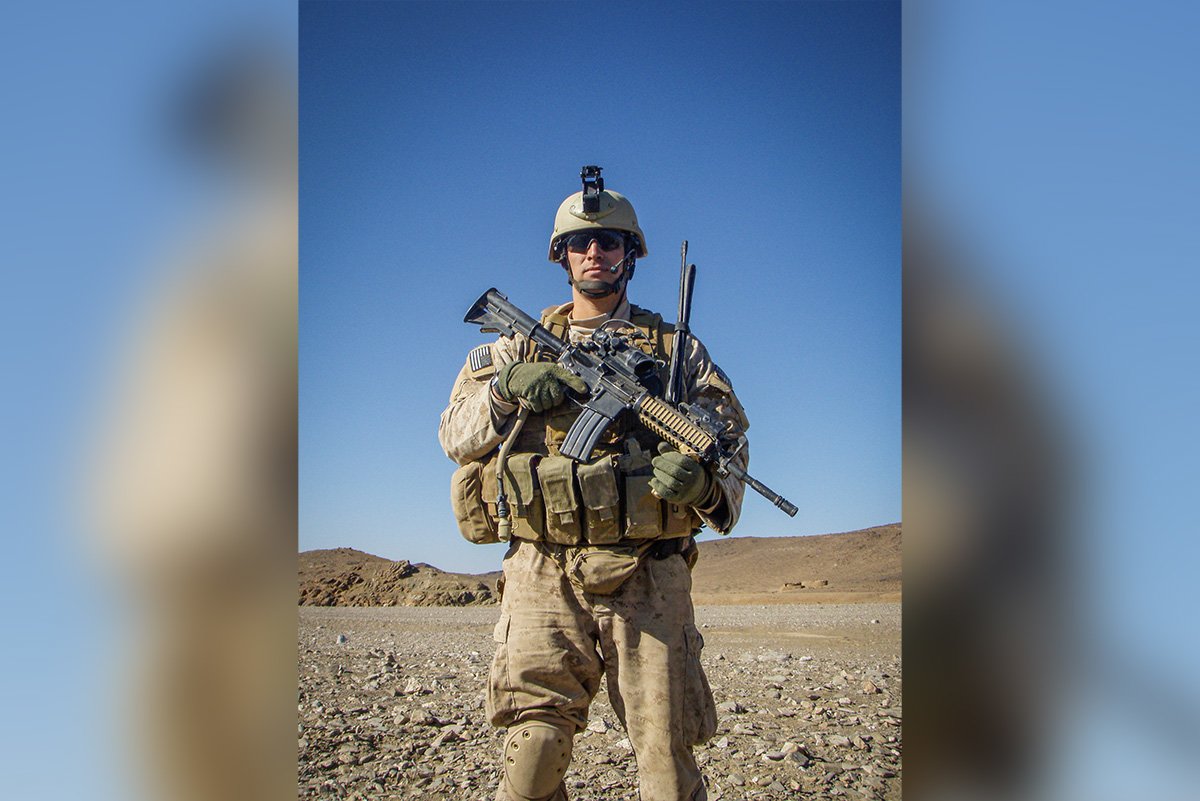
In the summer of 2008, Farah province was the wild west of the war-torn nation known as “the Graveyard of Empires.” The province borders Iran, spanning roughly 19,000 square miles in a mostly desert region, and is home to more than half a million Afghans spread across 11 districts.
When Marines from Golf, 2/7, deployed to Farah and Helmand provinces from Twentynine Palms, California, the war in Afghanistan was an afterthought in America’s collective consciousness. The news cycle was consumed by a rapidly accelerating financial collapse and a race for the White House between John McCain and a junior senator from Illinois named Barack Obama.
Many of the 2/7 Marines had seen combat in Iraq, but when they arrived in Afghanistan in April 2008, they found themselves spread thin over a massive area of responsibility. The unforgiving topography of the desolate, landlocked region provided an endless stream of logistical and operational challenges.
“We were drinking well water, eating fried potatoes and rice, and trying to find goats to eat,” recalls Steven Carper, a police officer in Greenville, Texas, who served as a corporal with Golf Company’s 2nd Platoon during the unit’s 2008 deployment. “We requested bullets and batteries, and they were sending us O’Doul’s and rotten fruit. There were points where we were carrying AK-47s and stuff because we could get them.”
Carper’s reinforced platoon of roughly 60 Marines was dispatched to a remote combat outpost in Farah’s Bala Buluk district. The small outpost marked the southwestern boundary of America’s conventional military presence in Afghanistan. The nearest friendly unit was another Golf Company platoon — nearly five hours by vehicle to the southeast.

On top of the spartan living conditions, the Marines quickly learned the Taliban fighters in Afghanistan were a much more formidable enemy than the insurgents they’d gone up against in Iraq.
“They were completely different from the enemy fighters in Iraq,” Carper said. “They were diehard, and they wanted a stand-up fight.”
Dozens of Taliban insurgents tried to overrun the small outpost twice, launching well-coordinated night raids. As recoilless rifles and RPGs exploded into the compound’s fortified Hesco barriers, the Marines fought for their lives, spraying an extraordinary volume of fire at the enemy. The fights were so intense that the barrels of the Marines’ machine guns glowed red in the night; one melted completely.
Throughout 2/7’s roughly nine-month deployment, the battalion suffered 19 Marines and an Afghan interpreter killed in action and 160 wounded, including 30 amputees.
Before the Marines arrived in April, Italian and Spanish forces had seen relatively minimal violence in the area. American planners seemed to expect the relative peace to continue as they sent Golf Company to bolster and train the Afghan National Security Forces and Police in the area — a key strategic objective for US and NATO forces across Afghanistan at the time.
The first two months of 2/7’s deployment seemed to be the calm before the storm. Then in the deadliest month of the deployment, nine Marines were killed in 11 days. It was June 2008.

In the early morning hours of Monday June 23, 2008, then Capt. Byron Owen — now a lieutenant colonel and the commanding officer of 3rd Radio Battalion — was asleep in his home on Camp Pendleton, California, when his phone rang. The Force Reconnaissance platoon commander picked up and listened to what he thought must have been a prank.
“It’s like one in the morning, and someone says, ‘Hey, you’ve got to go to Afghanistan by Friday,’ ” Owen recalls. “I thought it was a buddy, messing with me.”
It was actually the I Marine Expeditionary Force chief of staff. With the situation in southern Afghanistan quickly deteriorating and the Taliban insurgency growing bolder and deadlier, 2/7 needed help, and fast. Owen’s Force Recon Marines had an operational requirement of being rapidly deployable within days of being alerted, so when the I Marine Expeditionary Force commander needed a hammer for the Taliban nails in Farah province, he dispatched his most elite Marines.
“They were losing people left and right to death or injury,” recalls Alexander Cwalinski, then a sergeant in Force Recon. “They needed more men, and they needed men quickly. And we were one of the few units in the Marine Corps capable of just getting up and going.”
Owen’s platoon — call sign Jaeger— arrived in Afghanistan about a week after receiving their deployment order. When Gustafson’s patrol was ambushed, Jaeger’s leaders listened helplessly to radio communications from a command operations center at Camp Bastion in Helmand as the chaos unfolded. Shewan was at least a six-hour drive west.
“We felt completely impotent — 30 Marines ripping and raring to go, and there was nothing we could do to affect the situation,” Owen recalls.
“It’s like one in the morning, and someone says, ‘Hey, you’ve got to go to Afghanistan by Friday.’ I thought it was a buddy, messing with me.”
Home to several key leaders of the Taliban insurgency, Shewan was an enemy stronghold used to plan and stage attacks on coalition forces in the area. American intelligence estimated the village housed somewhere between 100 and 250 full-time fighters. Enemy control over Route 517 — the east-west running main supply route south of the village — isolated coalition and Afghan national forces in the western city of Farah from the rest of the Bala Buluk district, dramatically restricting their ability to accomplish their mission.
Previous attempts to enter the village and open up the route had resulted in bloody skirmishes that left many American or coalition troops killed or wounded, including another ambush June 26 in which then Staff Sgt. John Mosser, a member of Hotel Company, 2nd Marine Special Operations Battalion, earned a Navy Cross for pulling a severely wounded Marine out of the kill zone and fighting through the chaos to coordinate close air support and the extraction of the 22 members trapped in the ambush.
Marines from Mosser’s company told the Jaeger Marines that they tried to avoid Shewan and the 517 because they always took casualties in the area. The policy of avoidance didn’t sit well with Owen and his Marines.
On the morning of Aug. 8, 2008, Owen’s Force Recon platoon and Golf Company’s 2nd Platoon launched Operation Hammer and Anvil. The plan was for Owen’s Jaeger platoon to roll into the south side of Shewan with a lot of cocky swagger and kick the Taliban hornet’s nest.
Lt. Col. Mark Lenzi was a first lieutenant when he served as Golf Company’s executive during the unit’s 2008 deployment. Lenzi took charge of 2nd Platoon for the operation, and his unit — augmented by Afghan National Police — was to be the anvil and stage a blocking position on the city’s north side. The Marines hoped the Taliban would attack Golf 2 and the ANP forces from the north, fixing the enemy in place for a surprise attack from Jaeger on the eastern flank. The plan did not survive first contact with the enemy.
Sgt. Josh Basso was an assistant team leader for Jaeger 1 — one of the Force Recon platoon’s four teams of six men. When the Jaeger Marines received their mission brief early in the morning of Aug. 8, Basso was struck by the date on the screen: 080808.
“Oh shit. This can’t be good,” he grumbled to the Marine next to him.

The Jaeger Marines rolled into the southern side of Shewan in multiple Humvees, staging outside the village and sending two teams to patrol on foot into the village.
Gunnery Sgt. Frank Simmons, an instructor and recruiter with Reconnaissance Training Company on Camp Pendleton, was a sniper and assistant team leader with Jaeger 3 that day. The young corporal spent the initial hours of the mission patrolling with his team on foot through the village’s rocky, sepia-baked rolling hills, muddy farm fields, irrigation ditches, and dirt paths.
As Simmons’ team approached some farmers tending to their fields, the Afghan men flashed surprised looks before dropping their rakes and shovels and walking away and out of sight past a line of shrubs and trees.
When a report came over the radio that the women and children around Shewan were starting to leave the area, Simmons smiled at his teammates.
“It sounds like we’re in for a fight today,” he said.
Walking along the edge of the Farah Rud river, Simmons saw three motorcycles, each with two men, carrying saddlebags and heading toward him. After spotting the Marines, the riders slowed and quickly turned around. Simmons knelt down and got a better look at the men through the scope of his Mk 11 sniper rifle. He couldn’t see any weapons, but the looks on the men’s faces suggested they weren’t friendly.
“They don’t look happy to see us,” Simmons said, reporting the details to his team leader.
Continuing on, Simmons’ team discovered a heavily fortified fighting position built into an irrigation ditch. He wondered how many others there were.

With temperatures climbing into triple digits around noon, Jaeger 3 was out of water, and the Marines were sweating buckets through their uniforms and body armor. They headed south and linked up with the other dismounted Marines, led by Gunnery Sgt. Brian Blonder, Jaeger’s platoon sergeant. As they waited to be picked up by the vehicles staged in the rocky, desert terrain south of the city, Simmons and his team found a patch of shade by a nearby compound wall and plopped down in a security posture. They were all badly dehydrated and dealing with cottonmouth, headaches, and exhaustion.
“Well, we’re pretty much combat ineffective now,” Simmons said, half-joking to his teammates. They all agreed.
After the Jaeger Humvees arrived to pick up the dismounted Marines, an explosion rang out, and an enemy RPG whooshed toward them, hit the dirt, and exploded between two of the vehicles. Simmons and the Jaeger 3 Marines were so exhausted that none of them even moved from their position in the shade.
Sgt. Alex Cwalinski was driving the Humvee the RPG was meant for, and he could see the shooter behind a bush less than 100 yards to the north. Thank God for that guy’s terrible aim.
The RPG had sailed right past Owen’s shoulder, and he and every dismounted Marine but Blonder reflexively dropped to the ground and took cover to return fire. Standing unfazed by the threat, Blonder called out the direction, description, and distance of the small insurgent team. Then he aimed in with his rifle and settled into a natural respiratory pause as one of two insurgents stood up to fire another RPG.
“Blonder just slowly pulled the trigger and hit this dude in the fucking face from the standing position at about 100 yards,” Owen said, recalling the moment in May. “So the other bad guy just looked like, ‘I don’t know what this guy’s got going on, but fuck this.’ He just ran away back into the city. It was the most incredible thing I’ve ever seen, and in my opinion, completely changed the face of that battle.”
Blonder took off in pursuit of the other insurgents, telling his team of dismounted Marines, “Follow me; we’re going to get that fucker.” Within minutes, the insurgents were dead.
“Blonder just slowly pulled the trigger and hit this dude in the fucking face from the standing position at about 100 yards.”
As Simmons and Jaeger 3 loaded up in their Humvee and headed west, the Marines guzzled bottles of water and sucked down electrolyte packets. Simmons was about to refill his CamelBak when a massive concentration of gunfire erupted. He could see enemy RPGs to his front as Blonder’s voice squawked to life on the radio, reporting that enemy positions to the north were firing on the convoy.
Simmons’ driver cranked the Humvee right and drove north toward the sound of enemy contact. With a large irrigation ditch 30 yards in front of them, the driver turned left and positioned the Humvee parallel to it. Simmons’ team leader, Staff Sgt. Tommy Hartrick, dismounted and motioned for the team to follow him. Enemy rounds kicked up dirt around Hartrick’s feet, and he ran for cover in the trench.
“Follow Staff Sgt. Hartrick into the trench!” Simmons yelled as bursts of machine-gun fire started peppering the right side of the armored Humvee and the dirt in front of the vehicle. Before exiting, Simmons saw an RPG fly right past the windshield over the hood of his Humvee. Sgt. Aaron Alonso, the Marine manning the vehicle’s turret, opened up with his M240 machine gun, sending sustained bursts toward the enemy positions to the north.
Simmons and Sgt. Caleb Medley jumped out of the vehicle on the side taking fire as enemy rounds impacted all around them. Medley hit the deck and started firing bursts from his Squad Automatic Weapon — a light machine gun. The team’s Navy corpsman, “Doc” Everett, exited on the opposite side, and the three sprinted toward the trench, jumping in and landing hard. Simmons shuffled out of the trench and took cover behind a mound of dirt as the others spread out and found cover of their own.
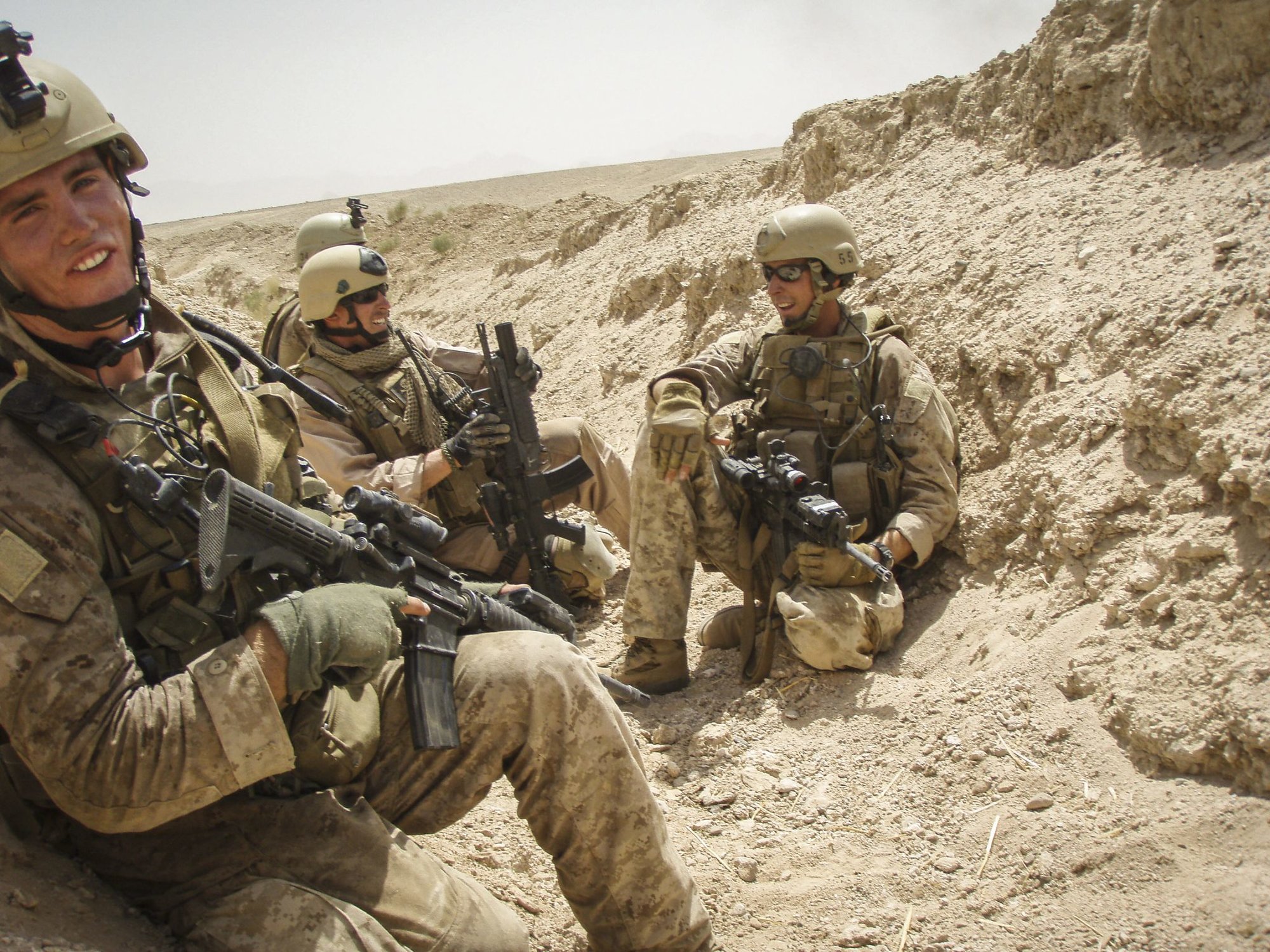
On the south side of the Farah Rud river just north of Shewan, Lt. Mark Lenzi and his Golf 2 Marines were in their blocking position with an 81 mm mortar team when they heard a heavy volume of small-arms fire coming from Jaeger’s location. Lenzi pulled his squad leaders together, and Sgt. Will Rollins, one of his best NCOs, convinced him the mortar team wouldn’t be able to support the Marines in contact from the blocking position. Golf 2 loaded up and moved to reinforce Owen’s platoon, pushing south through the village to Route 517. There, they turned left toward the area where dozens of Taliban insurgents had initiated a much larger coordinated attack on the Recon Marines from a covered trench line in a wooded area 200 meters south of the city.
Sgt. Basso, Jaeger 1’s assistant team leader, was in the passenger seat of his team’s Humvee when he heard the dismounted Marines were pinned down. He ordered his driver to head toward the enemy positions so Basso’s vehicle could suppress the enemy with its .50-caliber machine gun and draw fire away from the pinned-down Marines.
Cwalinski was driving a Humvee next to Basso’s as they and another Humvee rushed toward the fight. As the trio of vehicles approached a bend in an irrigation ditch, the Marines were unaware it was the enemy’s trench line. They accidentally drove right into a perfect L-shaped ambush.
When Basso’s .50-cal gunner opened up and started suppressing the trench line, the enemy unleashed everything they had at the vehicles. A massive volume of fire came at them from multiple directions.
Taliban fighters were everywhere. Basso’s gunner held the trigger down on his .50-cal, firing at a cyclic rate and traversing the turret back and forth. It was not enough to keep the enemy’s heads down.
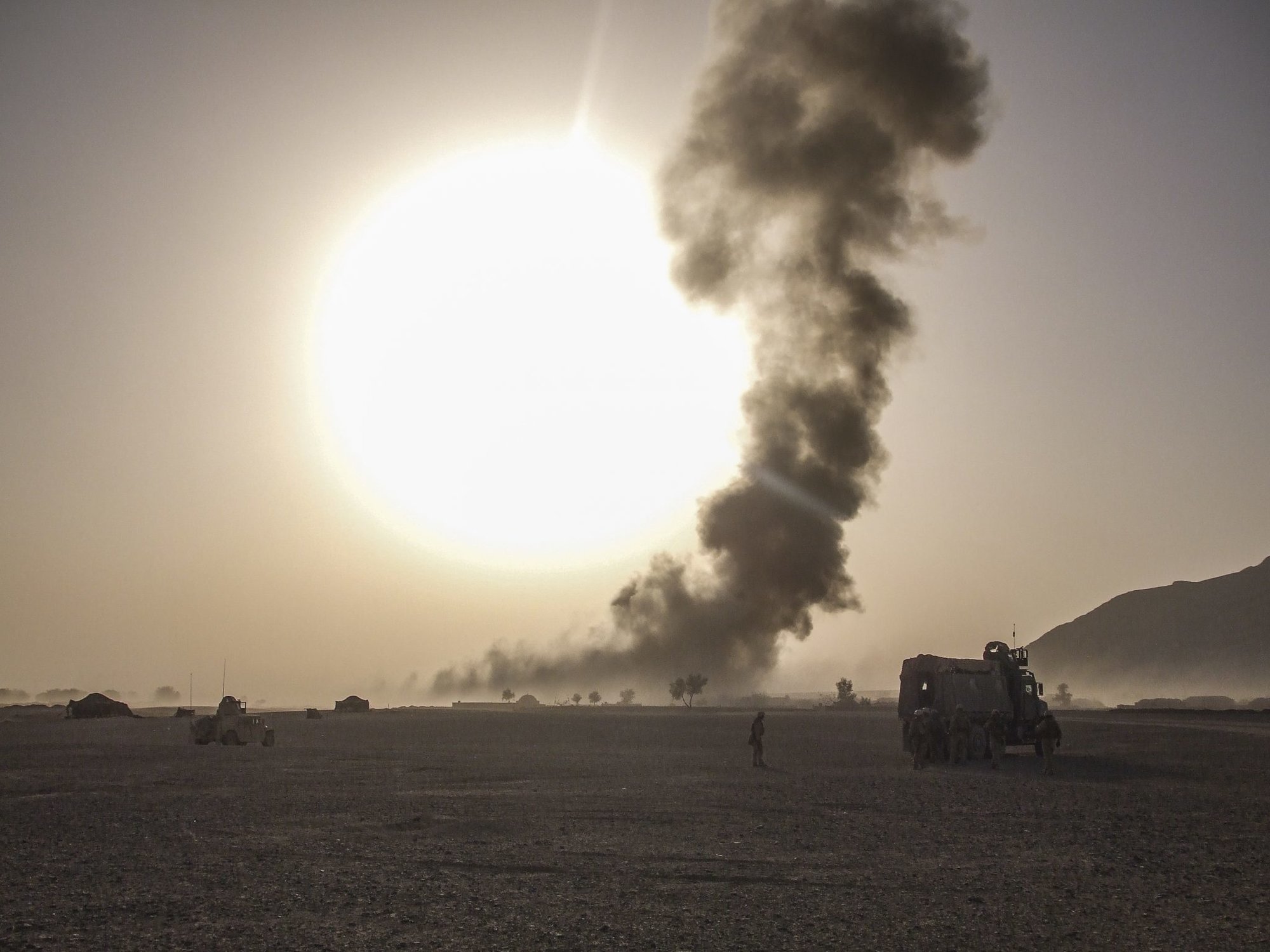
Around the same time, Sgt. Rollins was in the passenger seat of an MRAP driven by Steven Carper when they and the rest of Golf 2 banged a hard left off Route 517 and headed toward the fight. Rollins was focused on the three Recon Humvees taking fire near the L-shaped trench line when a mortar round landed 25 meters in front of his vehicle, peppering it with shrapnel. Unfazed, Carper and Rollins continued to push toward the Marines in contact.
Rounds snapped past the turret gunner’s head. As Rollins told Carper to push closer to the tree line, an RPG impacted in front of them, bounced off the ground and exploded in the air, again peppering the MRAP with shrapnel. Realizing they’d be unable to assault through the enemy’s position, Rollins ordered Carper to drive to the left to see if they could flank the enemy. He quickly realized that would require crossing over the enemy trench, so he told Carper to maneuver the MRAP back in the other direction.
That’s when Rollins and Carper saw RPGs slam into one of Jaeger’s Humvees and explode in a ball of smoke and fire.
Basso’s Humvee was within 100 yards of the tree line where the Taliban were attacking from multiple trenches. Rounds were impacting their vehicle almost nonstop. The enemy were shooting volleys of five to six RPGs at a time, and when the first one hit Basso’s vehicle it caught fire. Seeing no other choice, Basso tried to dismount. As he started to push open his Humvee door, an RPG skipped across the ground right in front of him, just barely missing. Before he could think twice about getting out, he looked up toward the front of the vehicle and the tree line just in time to see multiple enemy fighters firing RPGs straight at him.
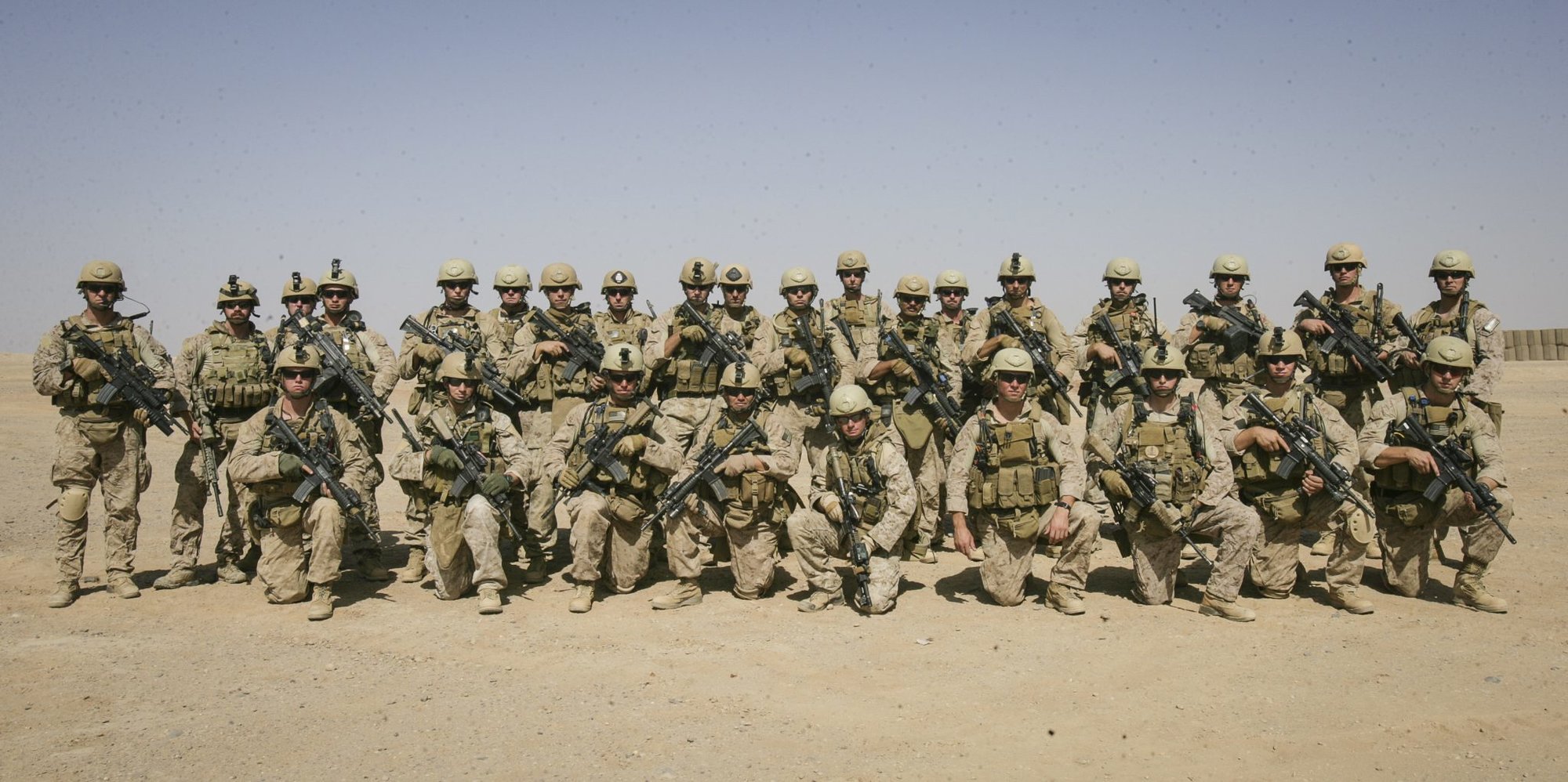
From his position on the berm, Simmons had a clear line of sight to most of the enemy trench line. RPGs whistled through the air as an ungodly cacophony of small-arms fire ripped and snapped all around.
As he peered through his sniper scope and scanned the tree line for targets, he heard a loud explosion and looked up to see a cloud of dust and smoke coming from the front of one of the three Jaeger Humvees in the kill zone about 150 meters to his left. Then another RPG slammed into the same vehicle, exploding in flames and more smoke and shrapnel. Then another, and another. The explosions happened so quickly, Simmons initially thought mortars were hitting the vehicles. Simmons and anyone else with a clear line of sight watched in horror as the vehicle’s gunner, Cpl. Jason White, flopped out of the turret and seemed to lifelessly roll off the roof of the Humvee.
Oh my God. They’re all dead, Simmons thought.
As the scene of what appeared to be his friends’ fiery death seemed to play in slow motion before Simmons, the violent machine-gun and RPG fire was relentless. Emboldened after taking out the Humvee, Taliban fighters climbed out of the trenches and irrigation ditches they’d been hiding in and rushed toward the burning vehicle. Simmons imagined the insurgents dragging his brothers’ bodies away and using them for propaganda videos.
“Fuck if that is happening,” he grumbled to himself, expecting not to survive much longer.
With nothing to lose but his life, Simmons went to work. As Taliban fighters ran toward the blown-up Humvee, Simmons started dropping them in rapid succession with his SR-25 Mk 11 sniper rifle. He employed a steady cadence, calmly locating a target in his reticle, bringing his surging adrenaline and pumping heart under control, and squeezing the trigger — methodically picking off enemy after enemy before they could kill his friends.
In a span of minutes, Simmons killed what he estimated to be eight Taliban fighters with eight upper-torso shots. Initially oblivious to the sniper fire, the enemy soon realized what was happening. They retreated back to a section of the trench line where the burning Humvee blocked Simmons’ view.
Determined to kill as many Taliban as he could, Simmons glassed the line until a group of five enemy fighters appeared in his scope. They were all within a few meters of one another, and most of their bodies were exposed above the trench. The leftmost fighter appeared to have an RPK light machine gun. The three middle fighters all had RPGs, and the farthest right insurgent had what looked like a PKM — a Soviet-style belt-fed machine gun.
Determined to kill as many Taliban as he could, Simmons glassed the line until a group of five enemy fighters appeared in his scope.
Enemy bullets snapped and whizzed all around Simmons, but none of them were coming from the five insurgents he’d sighted in on. Doing his best to ignore the explosions and rounds impacting all around him, Simmons went to work again.
He zoomed the magnification on his scope to 12X and shot the farthest right RPG gunner in the head. The insurgent’s head and neck cracked back from the shot, and he lifelessly slumped forward.
Simmons quickly moved to the next RPG gunner, who was aiming in the direction of the other Jaeger Humvees and didn’t seem to notice his buddy slumped over dead with a hole in his head. Simmons squeezed off another perfect head shot, and the second RPG gunner fell dead on his left side.
The third RPG gunner seemed to notice what was happening but seemed clueless as to where the deadeye sniper fire was coming from. He nervously lay down in the prone position, his upper chest and head still well exposed. Simmons shot him just below the neck, and the insurgent flopped face first into the dirt.
As soon as Simmons made that shot, the PKM gunner unleashed all his firepower on Simmons’ position. As rounds impacted all around him, Simmons thought about getting up and sprinting to a new location, but he was so exhausted he figured he couldn’t muster enough speed to make it without getting cut down. Simmons tried to quickly get his crosshairs on the gunner, but one of the PKM rounds hit right in front of Simmons’ face, sending rocks and dirt slamming into his teeth and forehead. He thought he’d been shot in the face.
After a moment passed, Simmons realized he was fine. Wiping the dirt from his eyes and stinging face, he got back on his rifle and aimed in just as the enemy’s PKM chewed through the last rounds of its ammunition belt. As his enemy frantically reloaded, Simmons sent a round directly into his chest, and he dropped face first into the stock of his weapon. He wriggled for a second and then stopped moving altogether.
Simmons then trained his reticle on the last of the five insurgents, who got up and ran down the trench to the sniper’s right. Simmons shot him below the armpit and watched him fall. He zoomed out to 4X magnification and started to scan for more targets as the last insurgent got back up and tried to hobble away. Simmons zoomed back in, fired another shot center mass, and watched him fall into the trench.

About 200 meters southwest of Simmons’ position, Will Rollins’ monstrous MRAP bucked and bounced violently as Steven Carper sped across the hard-baked, uneven terrain. As the volley of RPGs exploded into Basso’s Humvee, Rollins pointed toward the burning mass and told Carper, “Go, go, go!”
Carper and Rollins had already been through hell together several times over, and they shared the kind of unspoken bond that earned them the moniker “the dynamic duo” and usually put them on the same page when it came to making bold decisions under fire.
“Everybody recognized we had to get those Marines out of the kill zone, but as the rest of us were sort of reacting in that moment and trying to figure out how we’re going to create the conditions to do that, Rollins and Carper just acted,” Lenzi told Coffee or Die Magazine in June. “It wasn’t the first time they’d done something like that, and once they took off, we all just picked up the rate of fire to cover them.”
As Rollins’ MRAP sped toward the downed Humvee, the Marines scrambled out of the burning vehicle into a hail of bullets and explosions. Owen had his driver move his vehicle into the kill zone so his gunner could suppress the enemy and help the Marines escape. As bullets and RPGs impacted all around, Owen got out of his vehicle to coordinate the suppression of the enemy.
Sgt. Zachary Holm had been in the seat behind Basso when the RPGs hit their Humvee. At 6-foot-5 and 240 pounds, the massive Minnesotan jumped out of the vehicle with his M249 SAW machine gun, chicken-winging the weapon under his right elbow and laying down fire at the enemy. He grabbed Basso and dragged him out and behind cover. All the Marines exited the vehicle and took cover behind elevated terrain. They were completely pinned down in the middle of the kill zone.
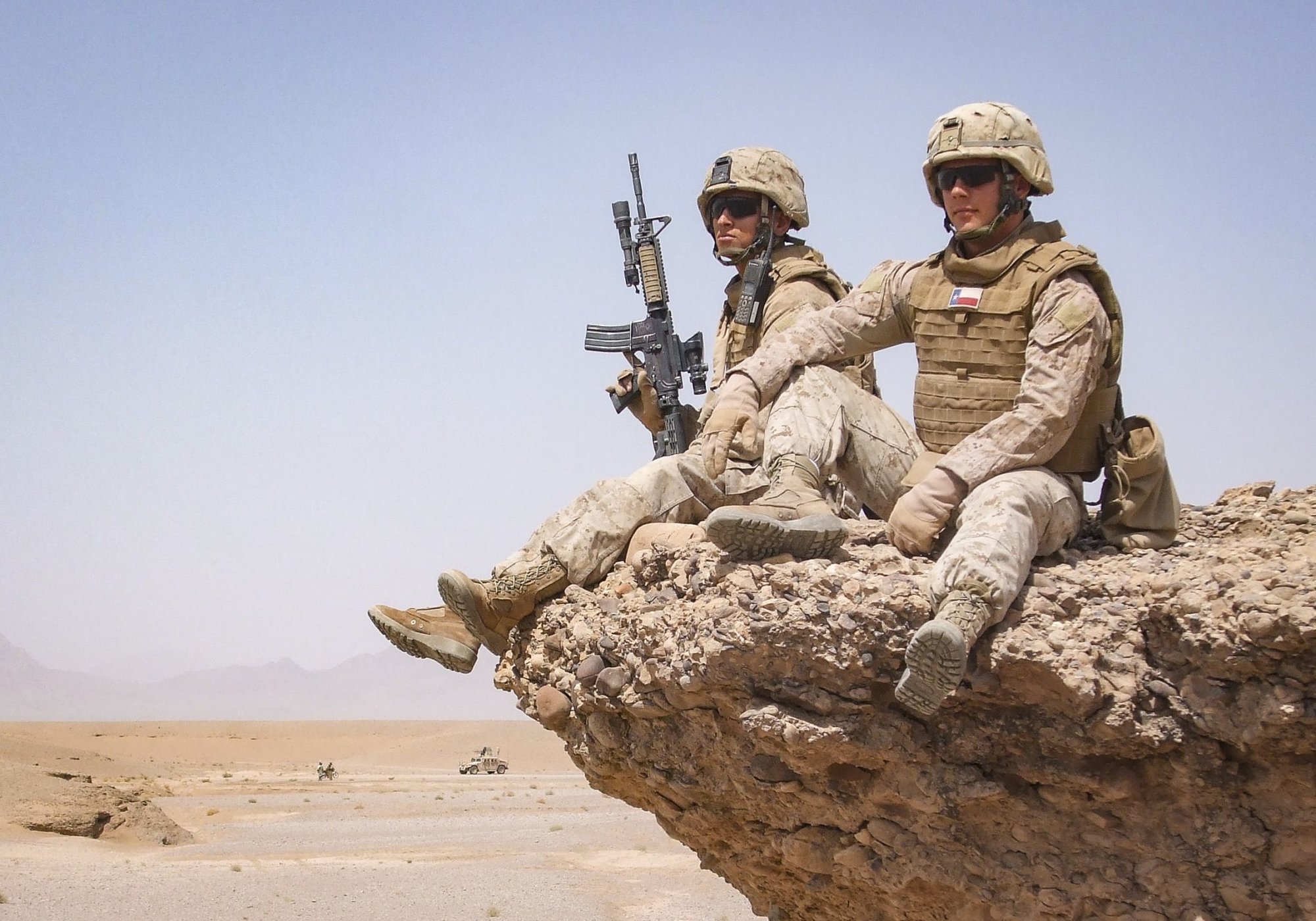
Rollins’ MRAP was taking heavy machine-gun fire as his own turret gunner laid down steady bursts at the enemy with his M240. A volley of RPGs flew over the vehicle, just missing. Then an RPG hit below the rear driver-side tire, shredding it. Carper was unfazed. He kept pushing and drove the MRAP up in front of the downed Humvee, putting it between the entrenched attackers and the pinned-down Marines. At the worst possible time, the machine gun in the turret jammed.
Carper swung his heavy door open and opened up with his M4, putting as much suppressive fire as possible toward the enemy threat. Rollins was mirroring Carper on the passenger side and firing at a cyclic rate as the Marines in the back of the MRAP opened the rear doors and rushed to evacuate the five wounded Recon Marines. Enemy rounds were impacting all around and snapping and hissing past.
With all Marines loaded into the MRAP, Carper and Rollins pulled back inside and slammed their armored doors shut. With the driver-side rear tire completely blown out and the driver front tire flat from shrapnel, Carper maneuvered out of the kill zone and drove the damaged vehicle back to a casualty collection point, where the Marines received medical treatment.
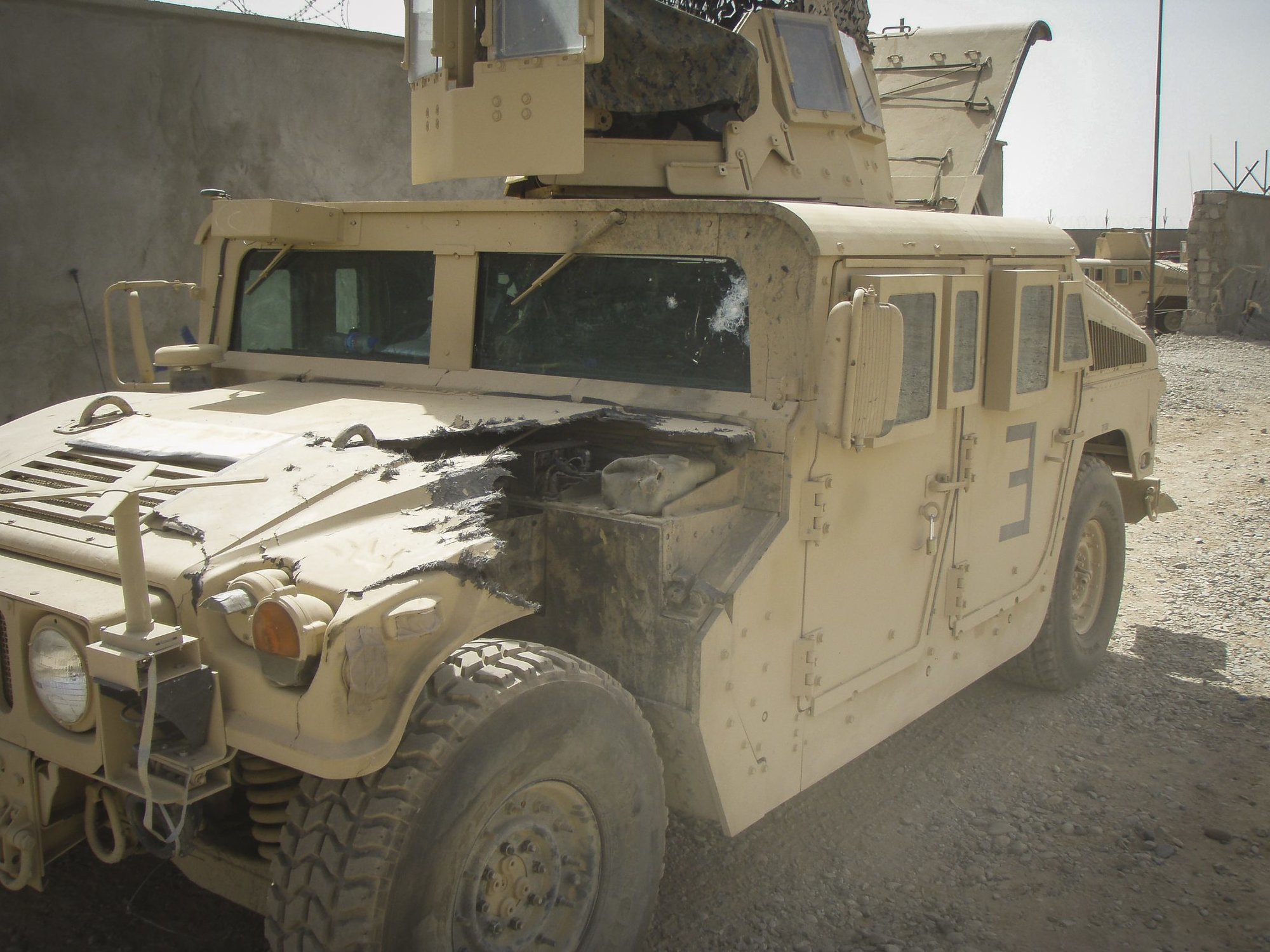
Just south of Simmons’ position on the berm, Sgt. Aaron Alonso watched from the turret of his Humvee as enemy rounds rained all around Simmons. The fire was so intense Alonso couldn’t see his friend’s body through all the dirt and dust. He assumed Simmons must be dead.
But Simmons was still very much in the fight. After he’d killed 13 of the Taliban fighters in a matter of minutes, the rest of the enemy force got wise and literally kept their heads down. Simmons glassed for targets, and anytime an insurgent revealed himself, he squeezed off a shot. Sometimes a large splash of blood would indicate a kill; other times dirt and dust would kick up as an insurgent would fall back behind a mud wall or cover.
Simmons was moving from one target to the next so fast, he couldn’t keep count of how many more enemy fighters he killed or wounded. Jaeger had 11 snipers on the battlefield that day, but Simmons’ 18 confirmed kills and numerous possibles in the first 10 minutes of the battle were vital to the Marines’ success that day.
“Every time the enemy stood up to take a shot with an RPG, he killed them,” Owen recalled. “And that’s what degraded the accuracy of the enemy’s fire. They kept seeing their people die, so they went from being able to put three RPGs in one spot to relatively inaccurate fire because no one was willing to stand up long enough to take a shot.”
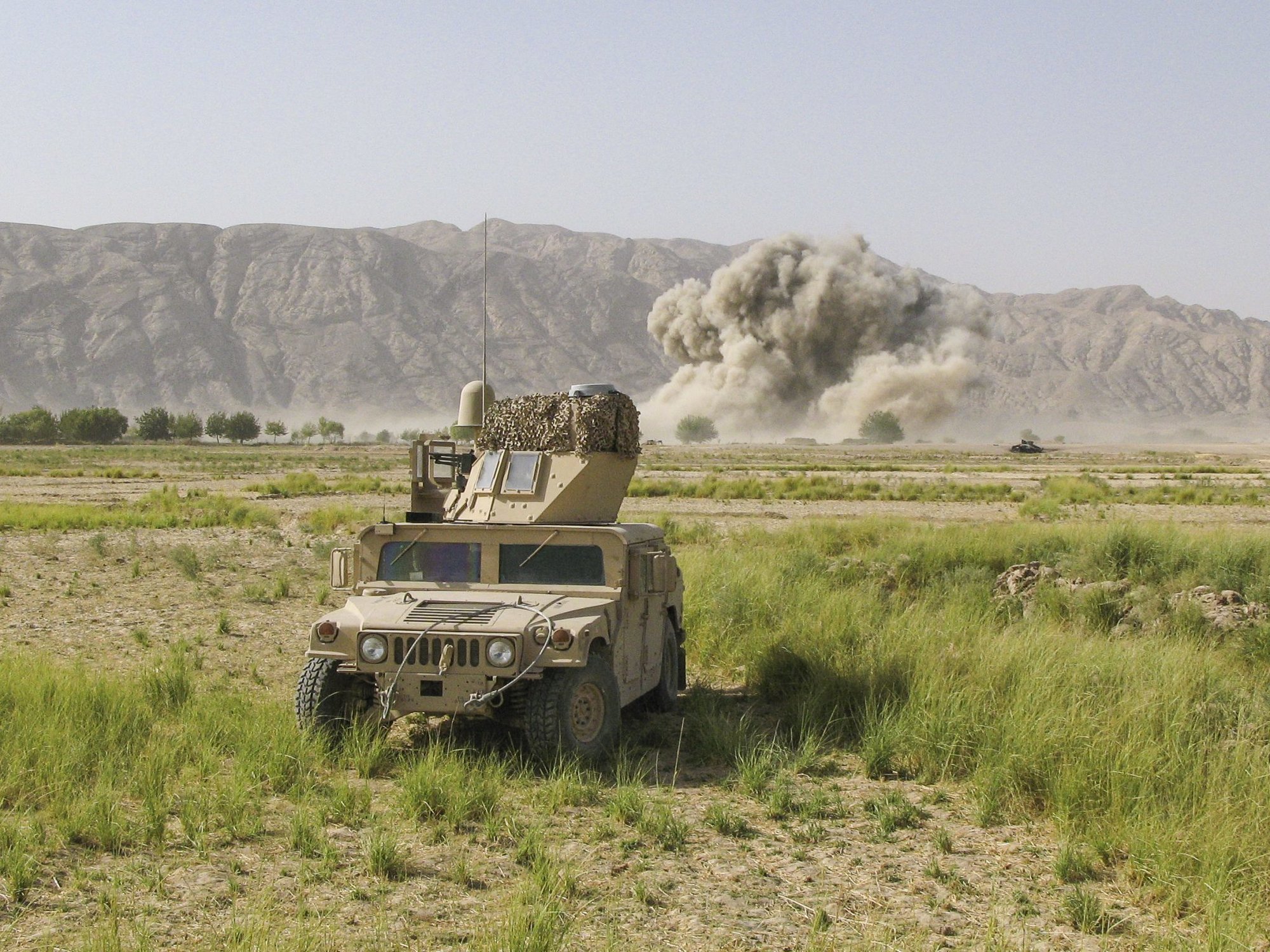
When Simmons finally took a moment to change positions and reload, he looked back toward the Humvees parked south of his position and saw Staff Sgt. D.J. Powell put his Mk 11 on the hood of his Humvee and kill an insurgent roughly 200 yards away. When another vehicle’s .50-cal jammed, the driver, Sgt. Jeremy Kanitz, jumped out, put his M14 Designated Marksman rifle over the hood of his Humvee, and killed another enemy fighter that Simmons couldn’t get an angle on.
Meanwhile, gunners in the vehicle turrets kept their guns talking back and forth, never letting their suppressive fire die down. Every Marine on the battlefield was in the fight of their lives, and they were killing a lot of Taliban. But for every enemy fighter killed, a steady stream of reinforcements seemed to spring from buildings and compounds in the city and surrounding areas.
Owen, whose Humvee had also been hit by an RPG and crippled in the kill zone, could see that his Marines were playing a game of whack-a-mole. The enemy was amassing reinforcements and trying to move on the Marines’ flanks. For the moment, the situation was tenable, but Owen knew it soon would not be. The Marines needed close air support to turn the tide of the battle in their favor.
Air assets were spread thin in the area, so when Owen’s forward air controller, Capt. Joe Begley, requested air support, the request was denied. Pinned down and pissed off, Owen got on the radio himself, stressing the extreme danger his Marines were facing and mentioning a code phrase used when a ground unit is facing imminent destruction.
Owen, whose Humvee had also been hit by an RPG and crippled in the kill zone, could see that his Marines were playing a game of whack-a-mole.
“I have a situation, and I cannot unstick myself,” Owen told the voice on the other end of the transmission. “I am not at the point where I would call Broken Arrow, but I probably will be within 20 minutes.”
Gen. Mark D. Kelly, then a colonel and now the commander of Air Combat Command, was piloting his F-15 over eastern Afghanistan on the other side of the country when the Joint Air Request center redirected him and his wingman to Farah province to help Owen and his Marines.
“What do you got down there?” Kelly asked when he arrived on station.
Owen described the situation and then asked Kelly what it looked like from the air.
“It looks like there’s a Snickers bar covered with ants, and you’re the candy bar,” Kelly replied.
“Yeah,” Owen shot back, “we’re looking at the same thing, buddy.”
Owen told Kelly he wanted him to drop 500-pound bombs in the enemy trench line within roughly 70 meters of Marines on the ground.
“I can’t do that,” Kelly said.
“Well, I don’t know what to tell you,” Owen replied. “That’s what I need, and if you don’t drop for me right now, your next drop is going to be on my position.”
Kelly and his wingman made a pass to get a closer look at their target before dropping their ordnance danger close to the Marines. The Marine commander watched camera footage from one of the F-15s later.

“It looked like a mosh pit,” Owen said, describing the footage. “This trench is just packed with fighters, and you can see people supplying it, reinforcing it. You can see trucks moving. It was a ton of people armed to the teeth. The pilot in the lead aircraft said to Kelly, ‘Mark, we’ve got to drop. They’re not going to be able to defend themselves from this.’ And so Kelly’s like, ‘Roger that. Wave off.’”
From his position behind his armored Humvee within 100 yards of the trench line, Owen watched Kelly’s F-15 come in at a dangerously low altitude. Slowing his speed to the point of almost stalling out, Kelly dropped his 500-pound bomb, keyholing the enemy trench with a perfect hit and then hitting his afterburner to climb away from the massive explosion as it decimated the enemy fighters in the trench.
With dozens of Taliban fighters now dead, the Jaeger Marines pulled back into a defensive perimeter about 600 meters to the south to reconsolidate. Several Recon Marines were suffering from dehydration and alarmingly close to going down with heat exhaustion. As everyone sucked down water, electrolytes, and food, a B-1 bomber made another run, dropping a 2,000-pound bomb on the enemy positions for the biggest explosion the Marines had seen yet.
“We having fun yet?” Simmons asked his teammates as everyone laughed and smiled at the awesome display of air power.
With all their people safely out of the kill zone and no one killed in action, the Marines could have called it a day and gone home, but Owen and Blonder knew that with the Taliban still dug in and able to reinforce and engage with effective fire, killing the remaining fighters and clearing through their stronghold was the only way to achieve victory. They brought together the platoon’s team leaders to discuss their options.
“If we leave right now, this is going to go in the L column, not the W,” Owen said to the group. “It will be perceived by everybody that we just lost this battle. We’ve got to go back in there and do this.”
Everyone agreed.
Lenzi and some of his Marines had linked up with Owen’s platoon at that point, and when Owen told Lenzi that Jaeger was going to stay and fight, the Golf 2 commander didn’t hesitate. “We’re staying too,” he told Owen, agreeing that a decisive victory was necessary to eliminate the Taliban’s ability to control the area of operations around Shewan and to send a message that would strike fear in the enemy going forward. After so many recent engagements resulting in American casualties, destroyed vehicles, and coalition forces having to break contact, it was time to punch the Taliban in the mouth and let them know what American Marines are made of. It was time for a counterattack.

They devised a plan: Marines and vehicles from Golf 2 would set up a support-by-fire position near the western entrance to the enemy trench line, while roughly half the Force Recon platoon, led by Blonder, would enter the trench from the east to conduct a battle damage assessment and clear out any remaining Taliban.
As Owen and Blonder prepared their Marines for the fight of their lives, two Recon Marines — Sgt. Phil Demers and Cpl. Tim Irwin — were suffering from heat exhaustion. Navy Petty Officer 1st Class Joe Martin, the platoon’s special amphibious reconnaissance corpsman, was administering IVs when Owen and Blonder approached. Martin explained that if the men participated in the assault, the exertion alone might kill them. Owen addressed his Marines.
“Gents, I know you’re in a bad way, but I need every Marine I can get in this fight,” Owen said. “What I’m asking you to do may cost you your life, but this one last thing may help save some of your brothers and accomplish the mission. This might be the last thing you do in your life, and you have an option.”
Demers pulled himself to his feet and asked, “Can I drop my blouse, sir?”
“If you want to fight in a T-shirt, that’s fine,” Owen said.
“We won’t let you down, sir,” Demers replied.
Lenzi, Rollins, and Carper volunteered to join the Recon Marines and the main clearing force. As they approached the trench line with Simmons and other Jaeger Marines, gunfire erupted to their front. The Marines returned fire and took cover as they bounded forward into the trench.
Heavy small-arms fire was coming from a courtyard roughly 135 meters north of their position. Enemy fire shredded the small bushes a foot above their heads, dumping leaves and twigs on them.
The Marines dispersed along the trench, and Blonder led half the Recon Marines down a fork in the trench that led to the northwest. Simmons stayed with the other half and the Golf 2 Marines, finding a somewhat covered and concealed position and scanning for enemy targets around the mud walls and livestock pens that were possible enemy positions.
Lenzi exposed himself to get better eyes on the courtyard where the enemy fire was coming from so he could help the forward air controller identify the target building they suspected was the Taliban command post and the main structure from which the enemy reinforcements kept coming.
As Lenzi crawled past Simmons, an insurgent popped up from another irrigation ditch near a series of compounds that Blonder and his team were advancing toward. Through his sniper scope, Simmons could make out the fighter’s black clothing, brown head wrap, and an RPG poking out on his right shoulder. He also had an AK-47, which he shouldered and aimed toward Blonder’s team. Simmons quickly shot him in the face at 150 yards, and he fell back against the tree, rolled to his right, and never moved again.
Simmons got word that another aircraft was inbound and about to drop a bomb on the enemy’s command center — another danger-close drop.
Lenzi propped himself up and leaned against the trench walls next to Rollins.
“Did you get him?” he asked Simmons.
“Yeah, he went to go see Allah,” Simmons responded, slightly gagging from the cottonmouth he was suffering due to dehydration.
As Blonder’s team took sustained enemy fire at their position to the northwest, the platoon sergeant called for more information from his team leaders, trying to work up another bombing run on the enemy position they were taking fire from.
Meanwhile, Simmons scanned for targets in the compounds across the farm fields in an area where Blonder and the other Marines were trying to maneuver on the enemy and positively identify bombing targets. Simmons trained his rifle on a mud wall of a compound where he could see the heads and shoulders of five Taliban fighters, one of whom was firing in the direction of Simmons and the Marines around him. Simmons opened up, firing 10 shots in rapid succession, pausing just long enough between shots to realign his sights. He later learned five enemy fighters were found dead in that compound with shots to the head and upper torso.
Off to Simmons’ left, his team leader, Staff Sgt. Hartrick, fired a 40 mm grenade from his M203 into an enemy position, flushing several fighters out from behind their cover, and Sgt. Holm cut them down with his M249 SAW.
Blonder and his element kept advancing north, moving through the trenches first and then compound to compound to close with and destroy the enemy. Holm and Staff Sgt. Garrett Dean infiltrated within 50 to 100 yards of a compound they identified as the Taliban’s main command operations center and reinforcement point. As the Marines worked up an airstrike on the compound, the Taliban fighters and leadership appeared intent on escaping, but every time enemy fighters stepped outside the building, one of the Jaeger’s 11 snipers would kill them. Their merciless efficiency shut the door on any chance of escape for the enemy.
Further south in the trench, Simmons got word that another aircraft was inbound and about to drop a bomb on the enemy’s command center — another danger-close drop. He passed word to everyone in the vicinity, and all the Marines got down as low as they could in the trench and opened their mouths to allow their bodies to better absorb any pressure from the bomb’s concussive blast.
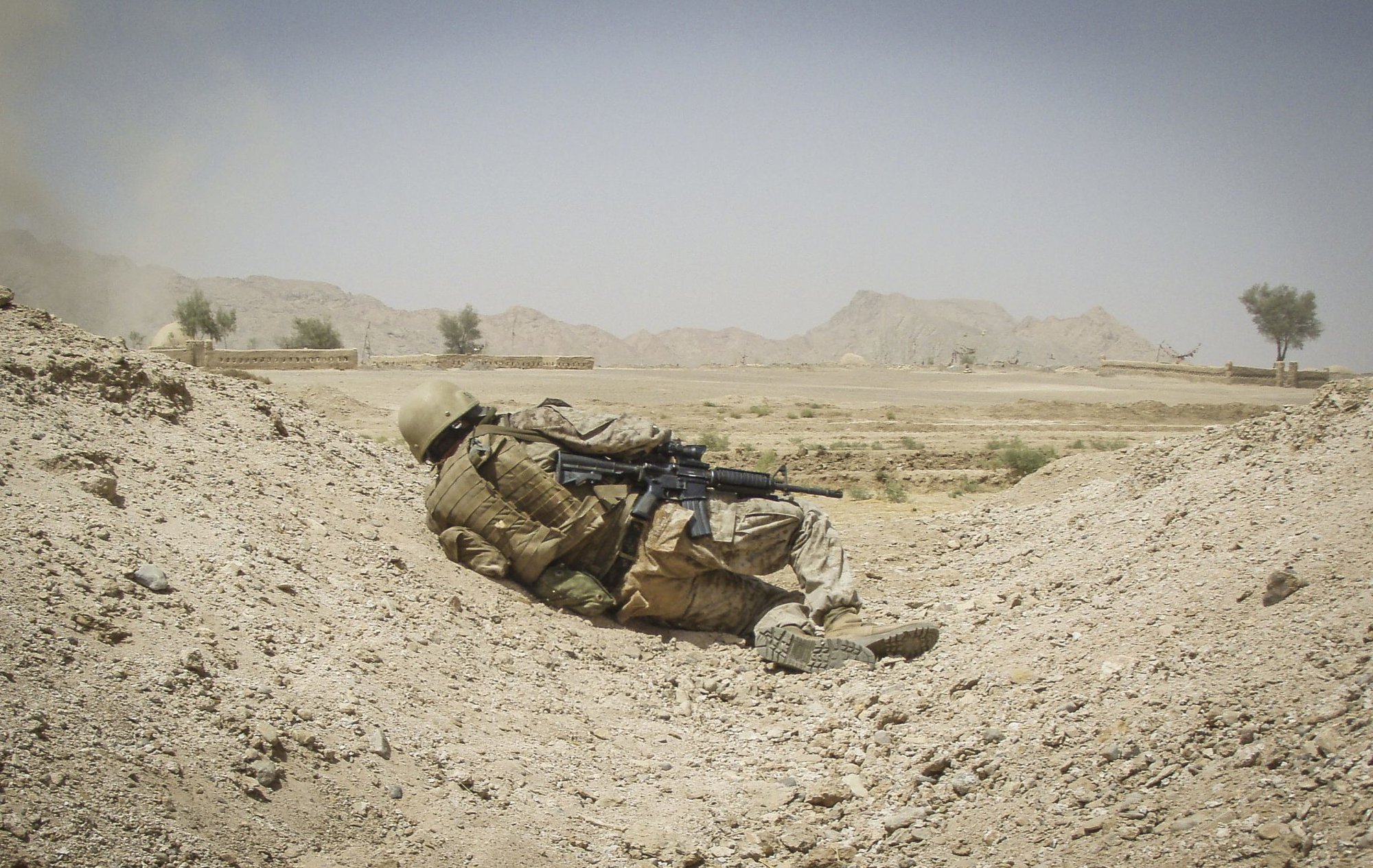
Just over 100 yards to the north of the Marines’ position in the trench, a perfectly dropped 500-pound bomb hit the Taliban command center. The massive explosion erupted in a ball of smoke and fire, annihilating the compound and sending debris and body parts showering down around the Marines in the trench.
The enemy guns were silenced.
“We slaughtered them all,” Simmons said, summing up the final outcome of the battle.
Owen and Blonder linked up and conducted a final battle damage assessment, walking freely anywhere on the battlefield. There were dead Taliban fighters and body parts strewn about everywhere. The Jaeger Marines and their Golf 2 brothers stood victorious and untouchable on the battlefield. Not a single Marine was killed in action, and at least 100 enemy fighters lay dead.
“We wanted anybody who was left there to see — we owned that piece of geography,” Owen said. “We won.”
During the eight-hour engagement, the Marines achieved a decisive victory, destroying a Taliban stronghold to seize control of Shewan’s portion of Route 517 and restoring freedom of movement in the area for coalition forces. For their actions that day, 11 Marines and two corpsmen received impact valor awards.
Blonder was awarded the Navy Cross. Owen and Simmons received Silver Stars — the nation’s third-highest valor award. Rollins, Lenzi, Dean, Holm, and Powell all received Bronze Stars for valor, while five others received the Navy and Marine Corps Commendation Medal with V for valor.
“We drove the enemy out of their homes, and then we left on our own terms when we were ready to,” Blonder told a Marine correspondent when he received his Navy Cross. “Every Marine out there was a huge part of that fight. […] Everyone contributed all they had.”
This article first appeared in the Winter 2022 edition of Coffee or Die’s print magazine as “Inside the Bloody Battle for Shewan.”
Read Next: What it Means to be a Marine Corps Scout Sniper, According to 5 Scout Snipers

Ethan E. Rocke is a contributor and former senior editor for Coffee or Die Magazine, a New York Times bestselling author, and award-winning photographer and filmmaker. He is a veteran of the US Army and Marine Corps. His work has been published in Maxim Magazine, American Legion Magazine, and many others. He is co-author of The Last Punisher: A SEAL Team THREE Sniper’s True Account of the Battle of Ramadi.
BRCC and Bad Moon Print Press team up for an exclusive, limited-edition T-shirt design!
BRCC partners with Team Room Design for an exclusive T-shirt release!
Thirty Seconds Out has partnered with BRCC for an exclusive shirt design invoking the God of Winter.
Lucas O'Hara of Grizzly Forge has teamed up with BRCC for a badass, exclusive Shirt Club T-shirt design featuring his most popular knife and tiomahawk.
Coffee or Die sits down with one of the graphic designers behind Black Rifle Coffee's signature look and vibe.
Biden will award the Medal of Honor to a Vietnam War Army helicopter pilot who risked his life to save a reconnaissance team from almost certain death.
Ever wonder how much Jack Mandaville would f*ck sh*t up if he went back in time? The American Revolution didn't even see him coming.
A nearly 200-year-old West Point time capsule that at first appeared to yield little more than dust contains hidden treasure, the US Military Academy said.












